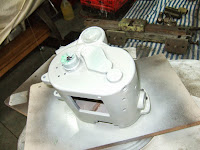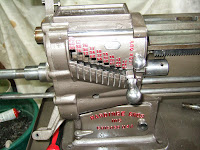Again almost all the parts are there, just dirty and some with a little coating of rust. As I work on this lathe I have come to realize that when I worked on the first lathe I missed a few oiling holes. I've come to the realization that if there's a hole in the casting fill it with oil. It will go somewhere to lubricate something. It's possible I was just a little anxious on the first one and went a little faster to be able to see the end result however with this one I'm going a little slower and I'm also more cognizant of where oil should be and therefore trying to ensure I have a clean gallery for it to get there. Another thing that came up was that either I'm unlucky with these two machines or there is an inherent weakness in the design of the three speed gear lever. On my #39 lathe this gear lever had been brazed back together and on this lathe the gear lever has also been brazed back together. Here are a couple pictures showing the repair job on the gear lever. I think if I ever get really ambitious I might pull this part apart again and try and make some drawings to make a pattern for this so as to cast some replacements.
Also heres a little description of the cleaning I'm doing. On the large items I use paint stripper to get rid of the majority of the old paint. Then all the parts go into a large pail and soak in varsol before I pull them out and finish the cleaning. Once they've been cleaned of gunk and old grease and oil I use a small wire wheel on my Foredom flexible shaft grinder to clean all the rest of the rust and paint away. I only do this on the cast surfaces and non critical machined surfaces. All critical bearing surfaces get cleaned and then I use either a scotchbrite pad or brass bristle brush to clean these surfaces. Then once it's all clean I tape it up and spray primer and then paint on the cast surfaces. All machined surfaces get a light coat of spindle oil to protect from flash rusting. Here's just a sample of one piece that is halfway through the cleaning process. Stripped on the right and still painted on the left. As well we also have a couple of pictures showing parts with primer and paint
Of course once everything is cleaned and painted, well then we've got to put it together again. Just to show you what we're up against here is a picture of all the parts from the Gear housing assembly. However once it's all back together it looks like the second photo which shows the assembly back on the lathe. It still needs some tweaking and installation of a couple of parts but the majority is there and there was only one requirement to remove and reinstall when I realized I had one of the bearing bushings installed backwards. On this assembly the only things missing were the split lock nut that goes on the leadscrew extension and the bolt and nut that holds the forward/reverse lever in place at the bottom of the arm. Just below the middle of the second picture where the arm touches the edge of the photo.
Towards the end of the week I also started on cleaning the Taper attachment I purchased recently. On every major part of the assembly is stamped a #30 so at one time this taper assembly belonged to Lathe #30. Greg assures me that the lathe body that this came off of has either a #80 or #83 stamped on the end. The last digit is hard to read. So at one time either the previous owner of that lathe rebuilt it with parts from another lathe or he purchased someone else's Taper attachment either because he lost his or it broke on him. I guess without a time machine we'll never know. (where is HG Wells when you need him) Here are a couple of pictures showing various parts of the Taper attachment drying after receiving a coat of primer.
Over the coming week I will try and finish the Taper attachment and then look at machining the 4 bolts required to attach it to the lathe as well I need to machine another setscrew for the gearing assembly mechanism. Finally will need to machine up a split nut that needs to be installed on the extension of the lead screw where it comes out on the left side of the change gear assembly.
Once the whole assembly was installed I played with the change gear lever and I definitely need to keep pressure on the lead screw, to the left, to prevent the gears from grinding. With this pressure placed on the shaft it again shows the gap by the "U" shaped spacer in the change gear assembly. I might still take the whole contraption apart and at least insert one brass washer and then bolt it together and see what the result is. I really do not like seeing that space there. I'll let you know next week what happened with this.
Finally last week I asked if anybody from Casa Grande was reading this. I am still hoping for somebody from that town to respond however I did manage to track down a person who used to live there for 20 years. With his help I think we've possibly narrowed down the building that Mr Potter from Practical Machinist believes houses another one of these lathes. I hope over the next week to try and see what luck I might have in tracking down the owner of the property. If I do I will see if he is willing to give us pictures and history on that lathe. Wish us luck. And as mentioned last week if you own one of these lathes or know somebody who does please if you haven't contacted me please do so.
See you all again next week. Lets also hope this nice fall weather stays around for awhile.
Harold



















































